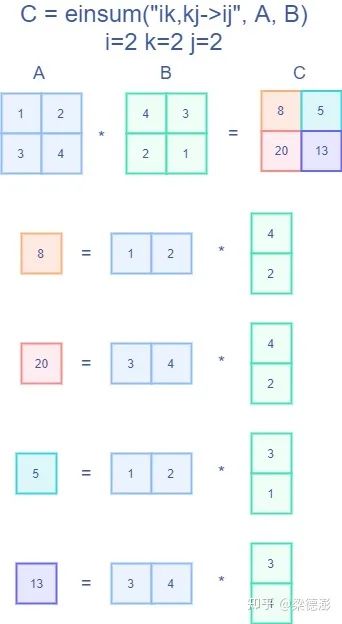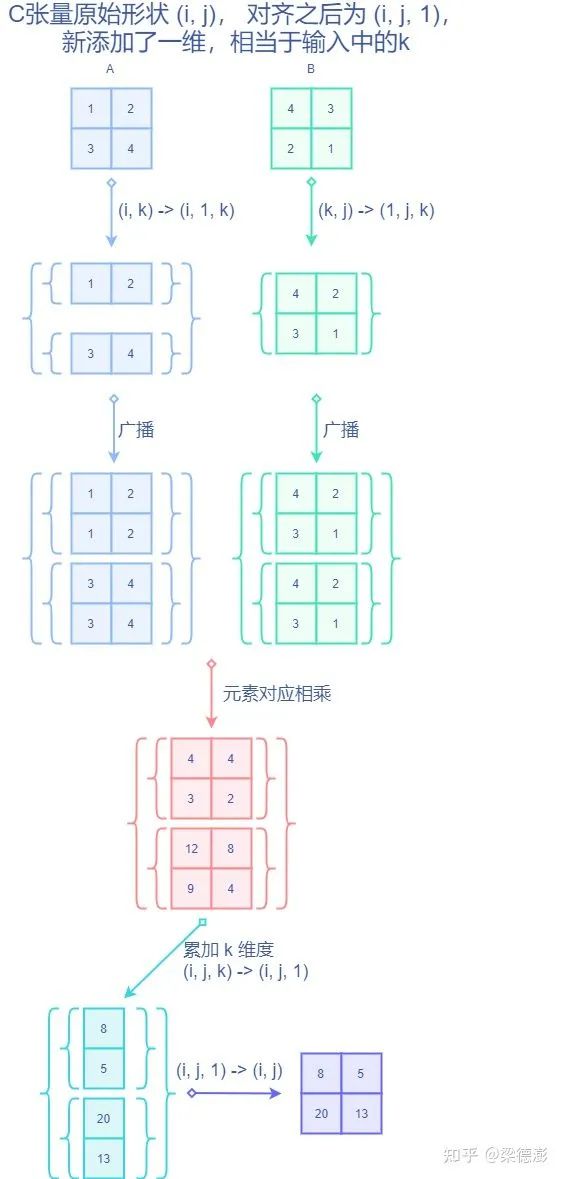一文轻松掌握深度学习框架中的einsum

导语:本文主要介绍了如何理解 PyTorch 中的爱因斯坦求和 (einsum) ,并结合实际例子讲解和 PyTorch C++实现代码解读,希望读者看完本文后掌握 einsum 的基本用法。
撰文|梁德澎
原文首发于公众号GiantpandaCV
1
爱因斯坦求和约定
爱因斯坦求和约定(einsum)提供了一套既简洁又优雅的规则,可实现包括但不限于:向量内积,向量外积,矩阵乘法,转置和张量收缩(tensor contraction)等张量操作,熟练运用 einsum 可以很方便地实现复杂的张量操作,而且不容易出错。
三条基本规则
首先看下 einsum 实现矩阵乘法的例子:
a = torch.rand(2,3)b = torch.rand(3,4)c = torch.einsum("ik,kj->ij", [a, b])# 等价操作 torch.mm(a, b)其中需要重点关注的是 einsum 的第一个参数 "ik,kj->ij",该字符串(下文以 equation 表示)表示了输入和输出张量的维度。equation 中的箭头左边表示输入张量,以逗号分割每个输入张量,箭头右边则表示输出张量。表示维度的字符只能是26个英文字母 'a' - 'z'。
而 einsum 的第二个参数表示实际的输入张量列表,其数量要与 equation 中的输入数量对应。同时对应每个张量的 子 equation 的字符个数要与张量的真实维度对应,比如 "ik,kj->ij" 表示输入和输出张量都是两维的。
equation 中的字符也可以理解为索引,就是输出张量的某个位置的值,是怎么从输入张量中得到的,比如上面矩阵乘法的输出 c 的某个点 c[i, j] 的值是通过 a[i, k] 和 b[k, j] 沿着 k 这个维度做内积得到的。
接着介绍两个基本概念,自由索引(Free indices)和求和索引(Summation indices):
-
自由索引,出现在箭头右边的索引,比如上面的例子就是 i 和 j;
-
求和索引,只出现在箭头左边的索引,表示中间计算结果需要这个维度上求和之后才能得到输出,比如上面的例子就是 k。
接着是介绍三条基本规则:
-
规则一:equation 箭头左边,在不同输入之间重复出现的索引表示,把输入张量沿着该维度做乘法操作,比如还是以上面矩阵乘法为例, "ik,kj->ij",k 在输入中重复出现,所以就是把 a 和 b 沿着 k 这个维度作相乘操作;
-
规则二:只出现在 equation 箭头左边的索引,表示中间计算结果需要在这个维度上求和,也就是上面提到的求和索引;
-
规则三:equation 箭头右边的索引顺序可以是任意的,比如上面的 "ik,kj->ij" 如果写成 "ik,kj->ji",那么就是返回输出结果的转置,用户只需要定义好索引的顺序,转置操作会在 einsum 内部完成。
特殊规则
特殊规则有两条:
-
equation 可以不写包括箭头在内的右边部分,那么在这种情况下,输出张量的维度会根据默认规则推导。就是把输入中只出现一次的索引取出来,然后按字母表顺序排列,比如上面的矩阵乘法 "ik,kj->ij" 也可以简化为 "ik,kj",根据默认规则,输出就是 "ij" 与原来一样;
-
equation 中支持 "..." 省略号,用于表示用户并不关心的索引,比如只对一个高维张量的最后两维做转置可以这么写:
a = torch.randn(2,3,5,7,9)# i = 7, j = 9b = torch.einsum('...ij->...ji', [a])2
实际例子解读
接下来将展示13个具体的例子,在这些例子中会将 PyTorch einsum 与对应的 PyTorch 张量接口和 Python 简单的循环展开实现做对比,希望读者看完这些例子之后能轻松掌握 einsum 的基本用法。
实验代码github链接:
https://github.com/Ldpe2G/CodingForFun/tree/master/einsum_ex
1.提取矩阵对角线元素
import torchimport numpy as npa = torch.arange(9).reshape(3, 3)# i = 3torch_ein_out = torch.einsum('ii->i', [a]).numpy()torch_org_out = torch.diagonal(a, 0).numpy()np_a = a.numpy()# 循环展开实现np_out = np.empty((3,), dtype=np.int32)# 自由索引外循环for i in range(0, 3): # 求和索引内循环 # 这个例子并没有求和索引, # 所以相当于是1 sum_result = 0 for inner in range(0, 1): sum_result += np_a[i, i] np_out[i] = sum_resultprint("input:\n", np_a)print("torch ein out: \n", torch_ein_out)print("torch org out: \n", torch_org_out)print("numpy out: \n", np_out)print("is np_out == torch_ein_out ?", np.allclose(torch_ein_out, np_out))print("is torch_org_out == torch_ein_out ?", np.allclose(torch_ein_out, torch_org_out))# 终端打印结果# input:# [[0 1 2]# [3 4 5]# [6 7 8]]# torch ein out:# [0 4 8]# torch org out:# [0 4 8]# numpy out:# [0 4 8]# is np_out == torch_ein_out ? True# is torch_org_out == torch_ein_out ? True2. 矩阵转置
import torchimport numpy as npa = torch.arange(6).reshape(2, 3)# i = 2, j = 3torch_ein_out = torch.einsum('ij->ji', [a]).numpy()torch_org_out = torch.transpose(a, 0, 1).numpy()np_a = a.numpy()# 循环展开实现np_out = np.empty((3, 2), dtype=np.int32)# 自由索引外循环for j in range(0, 3): for i in range(0, 2): # 求和索引内循环 # 这个例子并没有求和索引 # 所以相当于是1 sum_result = 0 for inner in range(0, 1): sum_result += np_a[i, j] np_out[j, i] = sum_resultprint("input:\n", np_a)print("torch ein out: \n", torch_ein_out)print("torch org out: \n", torch_org_out)print("numpy out: \n", np_out)print("is np_out == torch_org_out ?", np.allclose(torch_ein_out, np_out))print("is torch_ein_out == torch_org_out ?", np.allclose(torch_ein_out, torch_org_out))# 终端打印结果# input:# [[0 1 2]# [3 4 5]]# torch ein out:# [[0 3]# [1 4]# [2 5]]# torch org out:# [[0 3]# [1 4]# [2 5]]# numpy out:# [[0 3]# [1 4]# [2 5]]# is np_out == torch_org_out ? True# is torch_ein_out == torch_org_out ? True3. permute 高维张量转置
import torchimport numpy as npa = torch.randn(2,3,5,7,9)# i = 7, j = 9torch_ein_out = torch.einsum('...ij->...ji', [a]).numpy()torch_org_out = a.permute(0, 1, 2, 4, 3).numpy()np_a = a.numpy()# 循环展开实现np_out = np.empty((2,3,5,9,7), dtype=np.float32)# 自由索引外循环for j in range(0, 9): for i in range(0, 7): # 求和索引内循环 # 这个例子没有求和索引 sum_result = 0 for inner in range(0, 1): sum_result += np_a[..., i, j] np_out[..., j, i] = sum_resultprint("is np_out == torch_org_out ?", np.allclose(torch_ein_out, np_out))print("is torch_ein_out == torch_org_out ?", np.allclose(torch_ein_out, torch_org_out))# 终端打印结果# is np_out == torch_org_out ? True# is torch_ein_out == torch_org_out ? True4. reduce sum
import torchimport numpy as npa = torch.arange(6).reshape(2, 3)# i = 2, j = 3torch_ein_out = torch.einsum('ij->', [a]).numpy()torch_org_out = torch.sum(a).numpy()np_a = a.numpy()# 循环展开实现np_out = np.empty((1, ), dtype=np.int32)# 自由索引外循环# 这个例子中没有自由索引# 相当于所有维度都加一起for o in range(0 ,1): # 求和索引内循环 # 这个例子中,i 和 j # 都是求和索引 sum_result = 0 for i in range(0, 2): for j in range(0, 3): sum_result += np_a[i, j] np_out[o] = sum_resultprint("input:\n", np_a)print("torch ein out: \n", torch_ein_out)print("torch org out: \n", torch_org_out)print("numpy out: \n", np_out)print("is np_out == torch_ein_out ?", np.allclose(torch_ein_out, np_out))print("is torch_org_out == torch_ein_out ?", np.allclose(torch_ein_out, torch_org_out))# 终端打印结果# input:# [[0 1 2]# [3 4 5]]# torch ein out:# 15# torch org out:# 15# numpy out:# [15]# is np_out == torch_ein_out ? True# is torch_org_out == torch_ein_out ? True5.矩阵按列求和
import torchimport numpy as npa = torch.arange(6).reshape(2, 3)# i = 2, j = 3torch_ein_out = torch.einsum('ij->j', [a]).numpy()torch_org_out = torch.sum(a, dim=0).numpy()np_a = a.numpy()# 循环展开实现np_out = np.empty((3, ), dtype=np.int32)# 自由索引外循环# 这个例子中是 jfor j in range(0, 3): # 求和索引内循环 # 这个例子中是 i sum_result = 0 for i in range(0, 2): sum_result += np_a[i, j] np_out[j] = sum_resultprint("input:\n", np_a)print("torch ein out: \n", torch_ein_out)print("torch org out: \n", torch_org_out)print("numpy out: \n", np_out)print("is np_out == torch_ein_out ?", np.allclose(torch_org_out, np_out))print("is torch_org_out == torch_ein_out ?", np.allclose(torch_org_out, torch_ein_out))# 终端打印输出# input:# [[0 1 2]# [3 4 5]]# torch ein out:# [3 5 7]# torch org out:# [3 5 7]# numpy out:# [3 5 7]# is np_out == torch_ein_out ? True# is torch_org_out == torch_ein_out ? True6. 矩阵向量乘法
import torchimport numpy as npa = torch.arange(6).reshape(2, 3)b = torch.arange(3)# i = 2, k = 3torch_ein_out = torch.einsum('ik,k->i', [a, b]).numpy()# 等价形式,可以省略箭头和输出torch_ein_out2 = torch.einsum('ik,k', [a, b]).numpy()torch_org_out = torch.mv(a, b).numpy()np_a = a.numpy()np_b = b.numpy()# 循环展开实现np_out = np.empty((2, ), dtype=np.int32)# 自由索引外循环# 这个例子是 ifor i in range(0, 2): # 求和索引内循环 # 这个例子中是 k sum_result = 0 for k in range(0, 3): sum_result += np_a[i, k] * np_b[k] np_out[i] = sum_resultprint("matrix a:\n", np_a)print("vector b:\n", np_b)print("torch ein out: \n", torch_ein_out)print("torch ein out2: \n", torch_ein_out2)print("torch org out: \n", torch_org_out)print("numpy out: \n", np_out)print("is np_out == torch_ein_out ?", np.allclose(torch_ein_out, np_out))print("is torch_ein_out2 == torch_ein_out ?", np.allclose(torch_ein_out2, torch_ein_out))print("is torch_org_out == torch_ein_out ?", np.allclose(torch_org_out, torch_ein_out))# 终端打印输出# matrix a:# [[0 1 2]# [3 4 5]]# vector b:# [0 1 2]# torch ein out:# [ 5 14]# torch ein out2:# [ 5 14]# torch org out:# [ 5 14]# numpy out:# [ 5 14]# is np_out == torch_ein_out ? True# is torch_ein_out2 == torch_ein_out ? True# is torch_org_out == torch_ein_out ? True7. 矩阵乘法
import torchimport numpy as npa = torch.arange(6).reshape(2, 3)b = torch.arange(15).reshape(3, 5)# i = 2, k = 3, j = 5torch_ein_out = torch.einsum('ik,kj->ij', [a, b]).numpy()# 等价形式,可以省略箭头和输出torch_ein_out2 = torch.einsum('ik,kj', [a, b]).numpy() torch_org_out = torch.mm(a, b).numpy()np_a = a.numpy()np_b = b.numpy()# 循环展开实现np_out = np.empty((2, 5), dtype=np.int32)# 自由索引外循环# 这个例子是 i 和 jfor i in range(0, 2): for j in range(0, 5): # 求和索引内循环 # 这个例子是 k sum_result = 0 for k in range(0, 3): sum_result += np_a[i, k] * np_b[k, j] np_out[i, j] = sum_resultprint("matrix a:\n", np_a)print("matrix b:\n", np_b)print("torch ein out: \n", torch_ein_out)print("torch ein out2: \n", torch_ein_out2)print("torch org out: \n", torch_org_out)print("numpy out: \n", np_out)print("is numpy == torch_ein_out ?", np.allclose(torch_ein_out, np_out))print("is torch_ein_out2 == torch_ein_out ?", np.allclose(torch_ein_out2, torch_ein_out))print("is torch_org_out == torch_ein_out ?", np.allclose(torch_org_out, torch_ein_out))# 终端打印输出# matrix a:# [[0 1 2]# [3 4 5]]# matrix b:# [[ 0 1 2 3 4]# [ 5 6 7 8 9]# [10 11 12 13 14]]# torch ein out:# [[ 25 28 31 34 37]# [ 70 82 94 106 118]]# torch ein out2:# [[ 25 28 31 34 37]# [ 70 82 94 106 118]]# torch org out:# [[ 25 28 31 34 37]# [ 70 82 94 106 118]]# numpy out:# [[ 25 28 31 34 37]# [ 70 82 94 106 118]]# is numpy == torch_ein_out ? True# is torch_ein_out2 == torch_ein_out ? True# is torch_org_out == torch_ein_out ? True8. 向量内积
import torchimport numpy as npa = torch.arange(3)b = torch.arange(3, 6) # [3, 4, 5]# i = 3torch_ein_out = torch.einsum('i,i->', [a, b]).numpy()# 等价形式,可以省略箭头和输出torch_ein_out2 = torch.einsum('i,i', [a, b]).numpy()torch_org_out = torch.dot(a, b).numpy()np_a = a.numpy()np_b = b.numpy() # 循环展开实现np_out = np.empty((1, ), dtype=np.int32)# 自由索引外循环# 这个例子没有自由索引for o in range(0, 1): # 求和索引内循环 # 这个例子是 i sum_result = 0 for i in range(0, 3): sum_result += np_a[i] * np_b[i] np_out[o] = sum_resultprint("vector a:\n", np_a)print("vector b:\n", np_b)print("torch ein out: \n", torch_ein_out)print("torch ein out2: \n", torch_ein_out2)print("torch org out: \n", torch_org_out)print("numpy out: \n", np_out)print("is np_out == torch_ein_out ?", np.allclose(torch_ein_out, np_out))print("is torch_ein_out2 == torch_ein_out ?", np.allclose(torch_ein_out2, torch_ein_out))print("is torch_org_out == torch_ein_out ?", np.allclose(torch_org_out, torch_ein_out))# 终端打印输出# vector a:# [0 1 2]# vector b:# [3 4 5]# torch ein out:# 14# torch ein out2:# 14# torch org out:# 14# numpy out:# [14]# is np_out == torch_ein_out ? True# is torch_ein_out2 == torch_ein_out ? True# is torch_org_out == torch_ein_out ? True9. 矩阵元素对应相乘并求reduce sum
import torchimport numpy as npa = torch.arange(6).reshape(2, 3)b = torch.arange(6,12).reshape(2, 3)# i = 2, j = 3torch_ein_out = torch.einsum('ij,ij->', [a, b]).numpy()# 等价形式,可以省略箭头和输出torch_ein_out2 = torch.einsum('ij,ij', [a, b]).numpy()torch_org_out = (a * b).sum().numpy()np_a = a.numpy()np_b = b.numpy() # 循环展开实现np_out = np.empty((1, ), dtype=np.int32)# 自由索引外循环# 这个例子没有自由索引for o in range(0, 1): # 求和索引内循环 # 这个例子是 i 和 j sum_result = 0 for i in range(0, 2): for j in range(0, 3): sum_result += np_a[i,j] * np_b[i,j] np_out[o] = sum_resultprint("matrix a:\n", np_a)print("matrix b:\n", np_b)print("torch ein out: \n", torch_ein_out)print("torch ein out2: \n", torch_ein_out2)print("torch org out: \n", torch_org_out)print("numpy out: \n", np_out)print("is np_out == torch_ein_out ?", np.allclose(torch_ein_out, np_out))print("is torch_ein_out2 == torch_ein_out ?", np.allclose(torch_ein_out2, torch_ein_out))print("is torch_org_out == torch_ein_out ?", np.allclose(torch_org_out, torch_ein_out))# 终端打印输出# matrix a:# [[0 1 2]# [3 4 5]]# matrix b:# [[ 6 7 8]# [ 9 10 11]]# torch ein out:# 145# torch ein out2:# 145# torch org out:# 145# numpy out:# [145]# is np_out == torch_ein_out ? True# is torch_ein_out2 == torch_ein_out ? True# is torch_org_out == torch_ein_out ? True10. 向量外积
import torchimport numpy as npa = torch.arange(3)b = torch.arange(3,7) # [3, 4, 5, 6]# i = 3, j = 4torch_ein_out = torch.einsum('i,j->ij', [a, b]).numpy()# 等价形式,可以省略箭头和输出torch_ein_out2 = torch.einsum('i,j', [a, b]).numpy()torch_org_out = torch.outer(a, b).numpy()np_a = a.numpy()np_b = b.numpy() # 循环展开实现np_out = np.empty((3, 4), dtype=np.int32)# 自由索引外循环# 这个例子是 i 和 jfor i in range(0, 3): for j in range(0, 4): # 求和索引内循环 # 这个例子没有求和索引 sum_result = 0 for inner in range(0, 1): sum_result += np_a[i] * np_b[j] np_out[i, j] = sum_resultprint("vector a:\n", np_a)print("vector b:\n", np_b)print("torch ein out: \n", torch_ein_out)print("torch ein out2: \n", torch_ein_out2)print("torch org out: \n", torch_org_out)print("numpy out: \n", np_out)print("is np_out == torch_ein_out ?", np.allclose(torch_ein_out, np_out))print("is torch_ein_out2 == torch_ein_out ?", np.allclose(torch_ein_out2, torch_ein_out))print("is torch_org_out == torch_ein_out ?", np.allclose(torch_org_out, torch_ein_out))# 终端打印输出# vector a:# [0 1 2]# vector b:# [3 4 5 6]# torch ein out:# [[ 0 0 0 0]# [ 3 4 5 6]# [ 6 8 10 12]]# torch ein out2:# [[ 0 0 0 0]# [ 3 4 5 6]# [ 6 8 10 12]]# torch org out:# [[ 0 0 0 0]# [ 3 4 5 6]# [ 6 8 10 12]]# numpy out:# [[ 0 0 0 0]# [ 3 4 5 6]# [ 6 8 10 12]]# is np_out == torch_ein_out ? True# is torch_ein_out2 == torch_ein_out ? True# is torch_org_out == torch_ein_out ? True11. batch 矩阵乘法
import torchimport numpy as npa = torch.randn(2,3,5)b = torch.randn(2,5,4)# i = 2, j = 3, k = 5, l = 4torch_ein_out = torch.einsum('ijk,ikl->ijl', [a, b]).numpy()torch_org_out = torch.bmm(a, b).numpy() np_a = a.numpy()np_b = b.numpy()# 循环展开实现np_out = np.empty((2, 3, 4), dtype=np.float32)# 自由索引外循环# 这个例子是 i,j和lfor i in range(0, 2): for j in range(0, 3): for l in range(0, 4): # 求和索引内循环 # 这个例子是 k sum_result = 0 for k in range(0, 5):sum_result += np_a[i, j, k] * np_b[i, k, l] np_out[i, j, l] = sum_resultprint("is np_out == torch_ein_out ?", np.allclose(torch_ein_out, np_out))print("is torch_org_out == torch_ein_out ?", np.allclose(torch_ein_out, torch_org_out))# 终端打印输出# is np_out == torch_ein_out ? True# is torch_org_out == torch_ein_out ? True12. 张量收缩(tensor contraction)
import torchimport numpy as npa = torch.randn(2,3,5,7)b = torch.randn(11,13,3,17,5)# p = 2, q = 3, r = 5, s = 7# t = 11, u = 13, v = 17, r = 5torch_ein_out = torch.einsum('pqrs,tuqvr->pstuv', [a, b]).numpy()torch_org_out = torch.tensordot(a, b, dims=([1, 2], [2, 4])).numpy()np_a = a.numpy()np_b = b.numpy()# 循环展开实现np_out = np.empty((2, 7, 11, 13, 17), dtype=np.float32)# 自由索引外循环# 这里就是 p,s,t,u和vfor p in range(0, 2): for s in range(0, 7): for t in range(0, 11): for u in range(0, 13):for v in range(0, 17): # 求和索引内循环 # 这里是 q和r sum_result = 0 for q in range(0, 3): for r in range(0, 5): sum_result += np_a[p, q, r, s] * np_b[t, u, q, v, r] np_out[p, s, t, u, v] = sum_resultprint("is np_out == torch_ein_out ?", np.allclose(torch_ein_out, np_out, atol=1e-6))print("is torch_ein_out == torch_org_out ?", np.allclose(torch_ein_out, torch_org_out, atol=1e-6))# 终端打印输出# is np_out == torch_ein_out ? True# is torch_ein_out == torch_org_out ? True13. 二次变换(bilinear transformation)
import torchimport numpy as npa = torch.randn(2,3)b = torch.randn(5,3,7)c = torch.randn(2,7)# i = 2, k = 3, j = 5, l = 7torch_ein_out = torch.einsum('ik,jkl,il->ij', [a, b, c]).numpy()m = torch.nn.Bilinear(3, 7, 5, bias=False)m.weight.data = btorch_org_out = m(a, c).detach().numpy()np_a = a.numpy()np_b = b.numpy()np_c = c.numpy()# 循环展开实现np_out = np.empty((2, 5), dtype=np.float32)# 自由索引外循环# 这里是 i 和 jfor i in range(0, 2): for j in range(0, 5): # 求和索引内循环 # 这里是 k 和 l sum_result = 0 for k in range(0, 3): for l in range(0, 7):sum_result += np_a[i, k] * np_b[j, k, l] * np_c[i, l] np_out[i, j] = sum_result# print("matrix a:\n", np_a)# print("matrix b:\n", np_b)print("torch ein out: \n", torch_ein_out)print("torch org out: \n", torch_org_out)print("numpy out: \n", np_out)print("is np_out == torch_ein_out ?", np.allclose(torch_ein_out, np_out))print("is torch_org_out == torch_ein_out ?", np.allclose(torch_ein_out, torch_org_out))# 终端打印输出# torch ein out:# [[-2.9185116 0.17024004 -0.43915534 1.5860008 10.016678 ]# [-0.48688257 -3.5114982 -0.7543343 -0.46790922 1.4816089 ]]# torch org out:# [[-2.9185116 0.17024004 -0.43915534 1.5860008 10.016678 ]# [-0.48688257 -3.5114982 -0.7543343 -0.46790922 1.4816089 ]]# numpy out:# [[-2.9185114 0.17023998 -0.4391551 1.5860008 10.016678 ]# [-0.4868826 -3.5114982 -0.7543342 -0.4679092 1.4816089 ]]# is np_out == torch_ein_out ? True# is torch_org_out == torch_ein_out ? True从上面的13个例子可以看出,只要确定了自由索引和求和索引,einsum 的输出计算都可以用一套比较通用的多层循来实现,外层的循环对应自由索引,内层循环对应求和索引。
3
PyTorch einsum 实现简要解读
C++ 代码解读
Github 代码链接:
https://github.com/pytorch/pytorch/blob/53596cdb7359116e8c8ae18ffef06f2677ad1296/aten/src/ATen/native/Linear.cpp#L148
我只读懂了大概的实现思路,然后按照我自己的理解添加了注释(仅供参考):
// 为了方便理解,我简化了大部分代码,// 并把对于 "..." 省略号的处理去掉了/ * 代码实现主要分为3大步: * 1. 解析 equation,分别得到输入和输出对应的字符串 * 2. 补全输出和输入张量的维度,通过 permute 操作对齐输入和输出的维度 * 3. 将维度对齐之后的输入张量相乘,然后根据求和索引累加*/Tensor einsum(std::string equation, TensorList operands) { // ...... // 把 equation 按照箭头分割 // 得到箭头左边输入的部分 const auto arrow_pos = equation.find("->"); const auto lhs = equation.substr(0, arrow_pos); // 获取输入操作数个数 const auto num_ops = operands.size(); // 下面循环主要作用是解析 equation 左边输入部分, // 按 ',' 号分割得到每个输入张量对应的字符串, // 并把并把每个 char 字符转成 int, 范围 [0, 25] // 新建 vector 保存每个输入张量对应的字符数组 std::vector<std::vector> op_labels(num_ops); std::size_t curr_op = 0; for (auto i = decltype(lhs.length()){0}; i < lhs.length(); ++i) { switch (lhs[i]) { // ...... case ',':// 遇到逗号,接下来解析下一个输入张量的字符串 ++curr_op; // ...... break; default: // ...... // 把 char 字符转成 intop_labels[curr_op].push_back(lhs[i] - 'a'); } } // TOTAL_LABELS = 26 constexpr int TOTAL_LABELS = 'z' - 'a' + 1; std::vector label_count(TOTAL_LABELS, 0); // 遍历所有输入操作数 // 统计 equation 中 'a' - 'z' 每个字符的出现次数 for(const auto i : c10::irange(num_ops)) { const auto labels = op_labels[i]; for (const auto& label : labels) { // ...... ++label_count[label]; } // ...... } // 创建一个 vector 用于保存 equation // 箭头右边输出的字符到索引的映射 std::vector label_perm_index(TOTAL_LABELS, -1); int64_t perm_index = 0; // ...... // 接下来解析输出字符串 if (arrow_pos == std::string::npos) { // 处理用户省略了箭头的情况, // ...... } else { // 一般情况 // 得到箭头右边的输出 const auto rhs = equation.substr(arrow_pos + 2); // 遍历输出字符串并解析 for (auto i = decltype(rhs.length()){0}; i 0 && label_perm_index[label] == -1) { label_perm_index[label] = perm_index++; } } // 对所有输入张量,同样补齐维度至与输出维度大小相同 // 最后对输入做 permute 操作,使得输入张量的每一维 // 与输出张量的每一维能对上 std::vector permuted_operands; for (const auto i: c10::irange(num_ops)) { // 保存输入张量最终做 permute 时候的维度映射 std::vector perm_shape(perm_index, -1); Tensor operand = operands[i]; // 取输入张量对应的 equation const auto labels = op_labels[i]; std::size_t j = 0; for (const auto& label : labels) { // ...... // 建立当前遍历到的输入张量字符到 // 输出张量的字符到的映射 // label: 当前遍历到的字符 // label_perm_index: 保存了输出字符对应的索引 // 所以 perm_shape 就是建立了输入张量的每一维度 // 与输出张量维度的对应关系 perm_shape[label_perm_index[label]] = j++; } // 如果输入张量的维度小于补全后的输出 // 那么 perm_shape 中一定存在值为 -1 的元素 // 那么相当于需要扩充输入张量的维度 // 扩充的维度添加在张量的尾部 for (int64_t& index : perm_shape) { if (index == -1) { // 在张量尾部插入维度1 operand = operand.unsqueeze(-1); // 修改了perm_shape中的index, // 因为是引用取值 index = j++; } } // 把输入张量的维度按照输出张量的维度重排,采用 permute 操作 permuted_operands.push_back(operand.permute(perm_shape)); } // ...... Tensor result = permuted_operands[0]; // ..... // 计算最终结果 for (const auto i: c10::irange(1, num_ops)) { Tensor operand = permuted_operands[i]; // 新建 vector 用于保存求和索引 std::vector sum_dims; // ...... // 详细的代码可以阅读 PyTorch 源码 // 这里我还没有完全理解 sumproduct_pair 的实现, // 里面用的是 permute + bmm, // 不过我觉得可以简单理解为 // 将张量做广播乘法,再根据求和索引做累加 result = sumproduct_pair(result, operand, sum_dims, false); } return result;}图解实现
下面还是用矩阵乘法来说明C++的实现思路,下图展示的是矩阵乘法的通用实现:

接下来展示C++的实现思路:

4
总结
通过上面的实际例子和代码解读,可以看到 einsum 非常灵活,可以方便地实现各种常用的张量操作。希望读者通过这篇文章也可以轻松掌握 einsum 的基本用法。文中对于 PyTorch C++实现代码的解析是基于作者自己的理解,如果觉得有误或者不理解的地方欢迎讨论。
参考资料
1.https://www.youtube.com/watch?v=pkVwUVEHmfI&ab_channel=AladdinPersson
2.https://rockt.github.io/2018/04/30/einsum
3.https://ajcr.net/Basic-guide-to-einsum/
4.https://obilaniu6266h16.wordpress.com/2016/02/04/einstein-summation-in-numpy/
其他人都在看
-
数据搬运的“诅咒”
-
一个黑客“沦落”为搬砖的CVer
-
岁末年初,为你打包了一份技术合订本
-
GPU架构变迁之AI系统视角:从费米到安培
-
计算机史最疯狂一幕:“蓝色巨人”奋身一跃
-
30年做成三家独角兽公司,AI芯片创业的底层逻辑
欢迎下载体验OneFlow新一代开源深度学习框架:GitHub - Oneflow-Inc/oneflow: OneFlow is a performance-centered and open-source deep learning framework.![]() https://github.com/Oneflow-Inc/oneflow/
https://github.com/Oneflow-Inc/oneflow/


